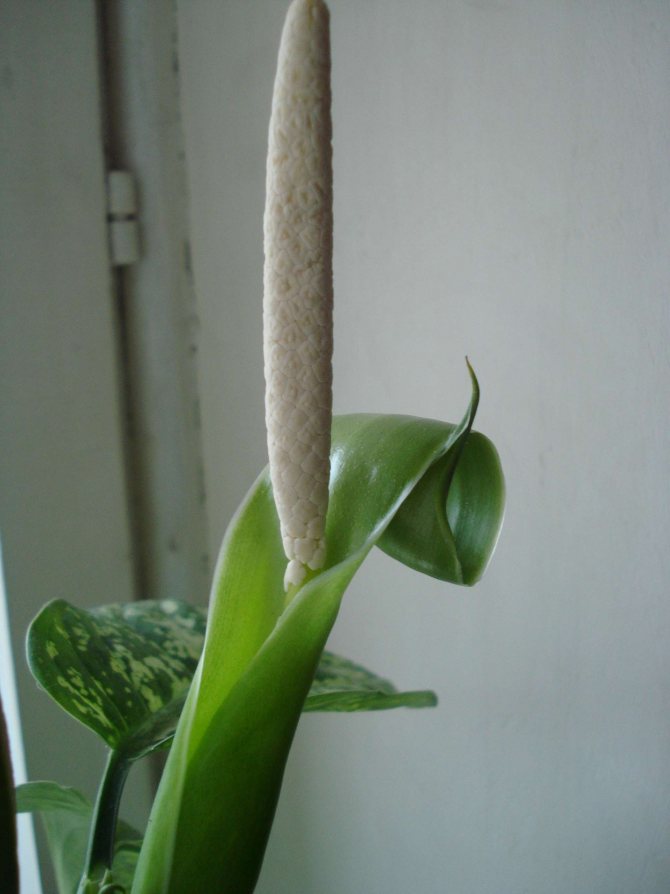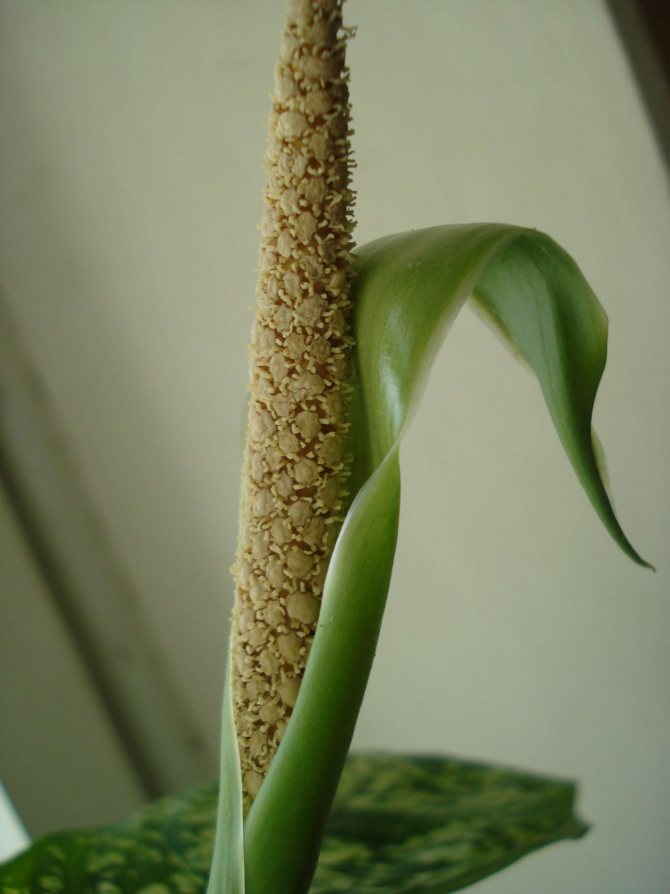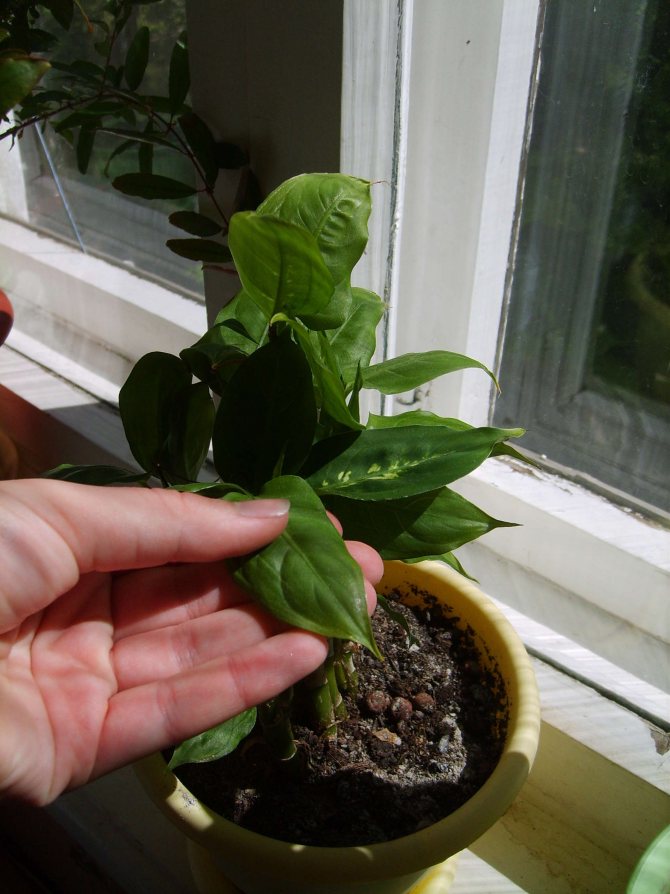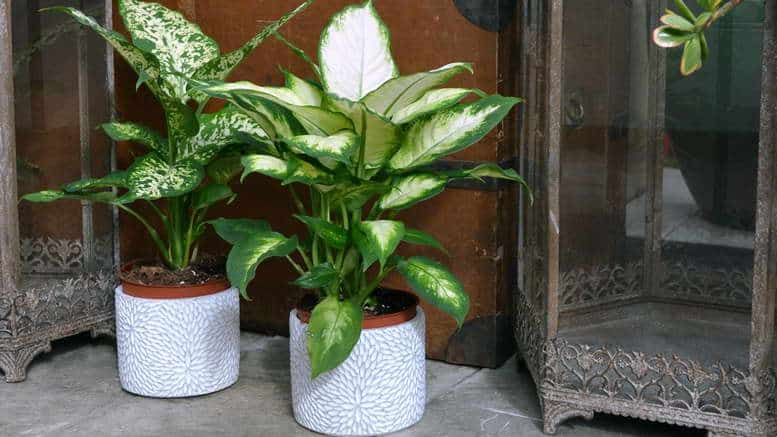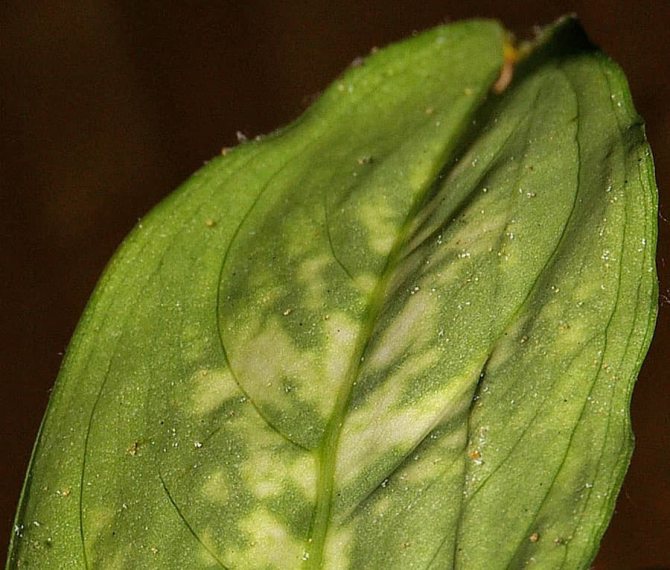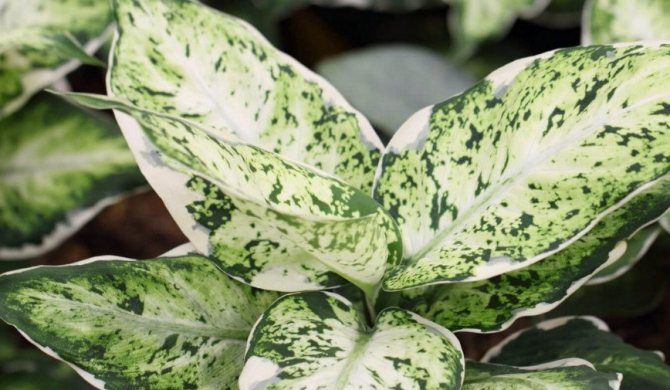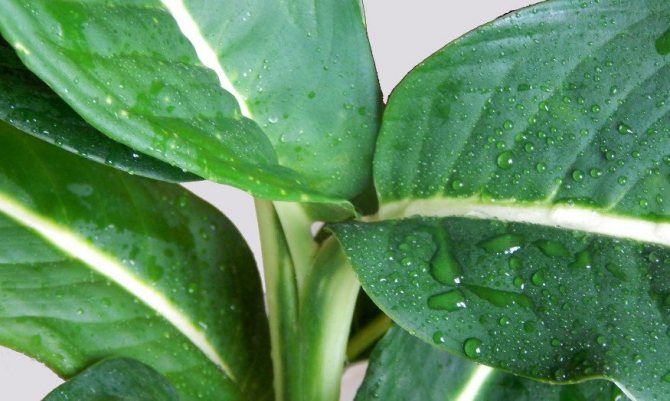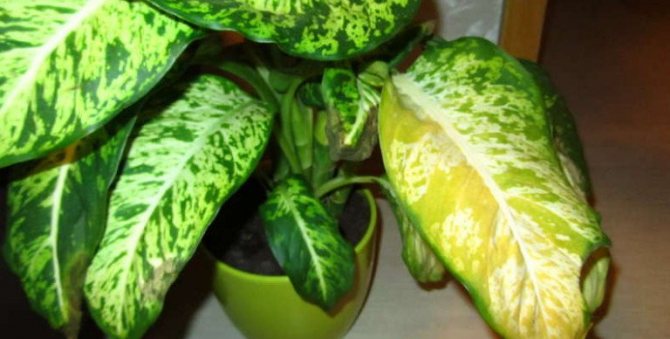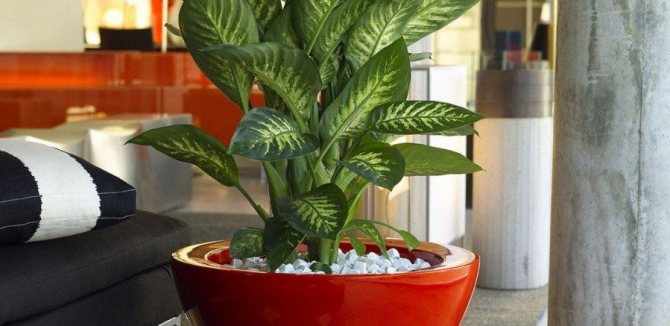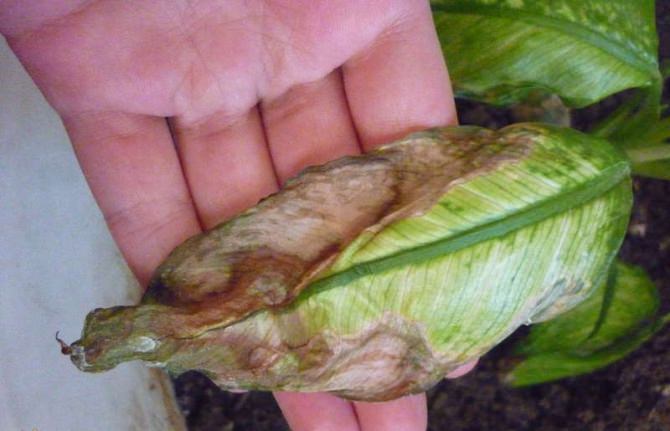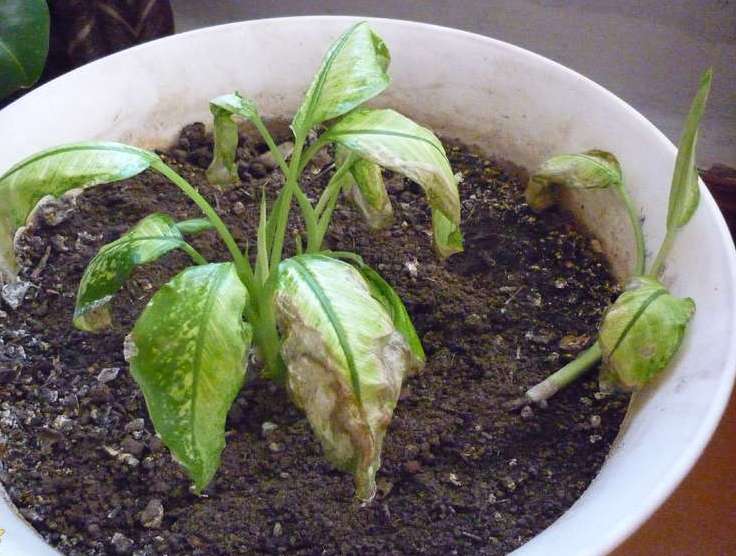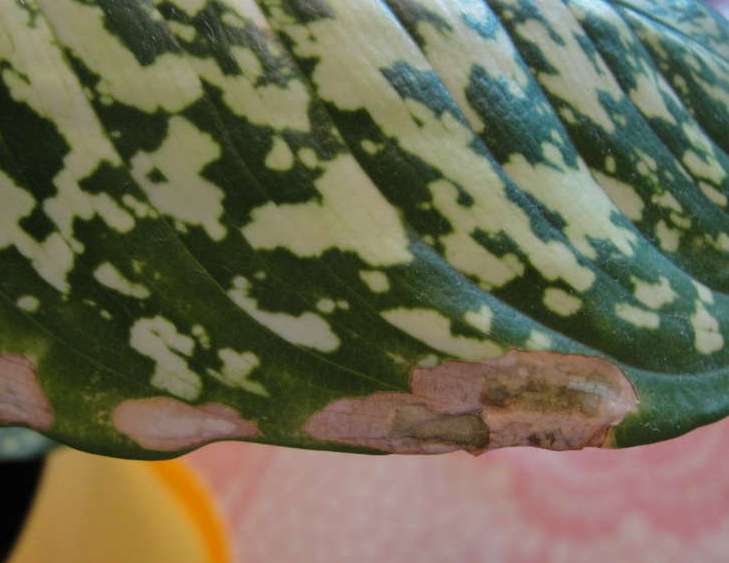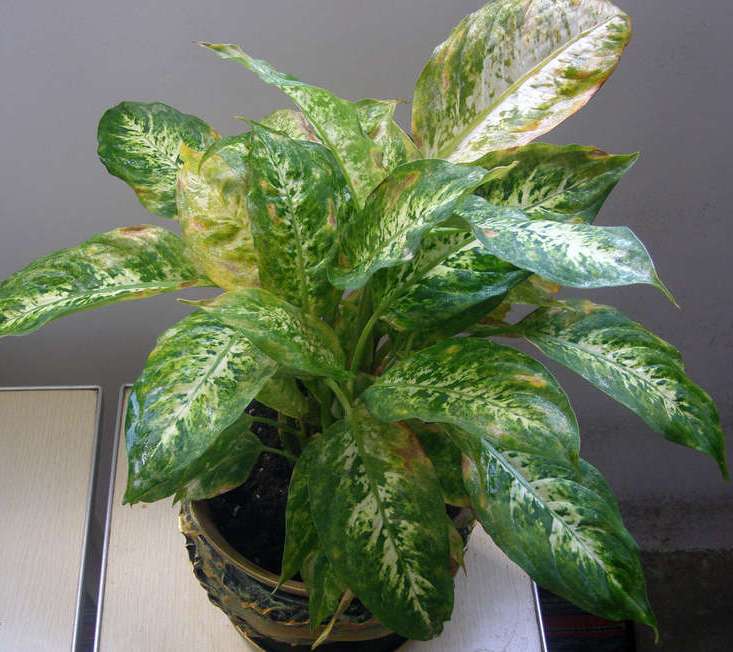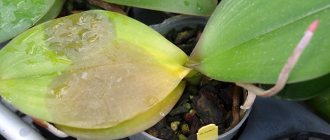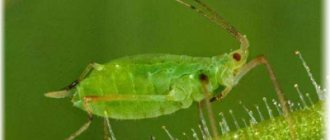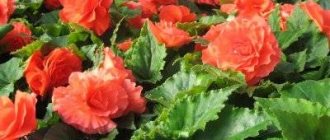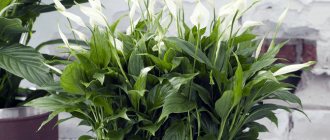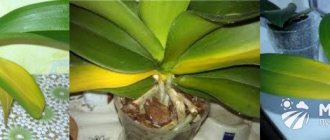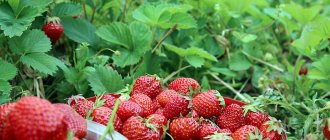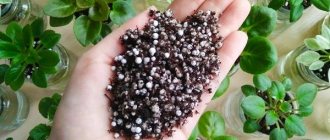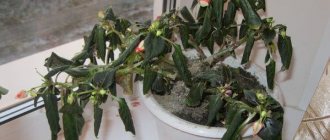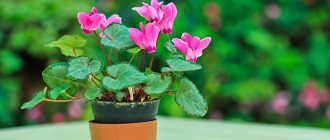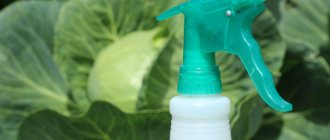Dieffenbachia is a perennial evergreen shrub with succulent stems native to the rainforests of South America. It was discovered in the 19th century by Heinrich Wilhelm Schott and was named after Joseph Dieffenbach, the chief caretaker of the botanical garden at Schönbrunn Palace in Vienna. Counts the genus that belongs to the family Aroid (Araceae, Arum), about 40 types of various herbs.
In its natural conditions, Dieffenbachia reaches a considerable height, but at home it rarely overcomes the 1.5 meter barrier. Dieffenbachia is prized for its beautiful mottled leaves, which have a varied pattern. The only drawback that you will find in this beautiful plant is that with active growth, it sheds the lower leaves, which exposes the trunk and deprives it of its decorative effect. But this problem is easily solved by renewing the plant by rooting the top. Some species are capable of bush.
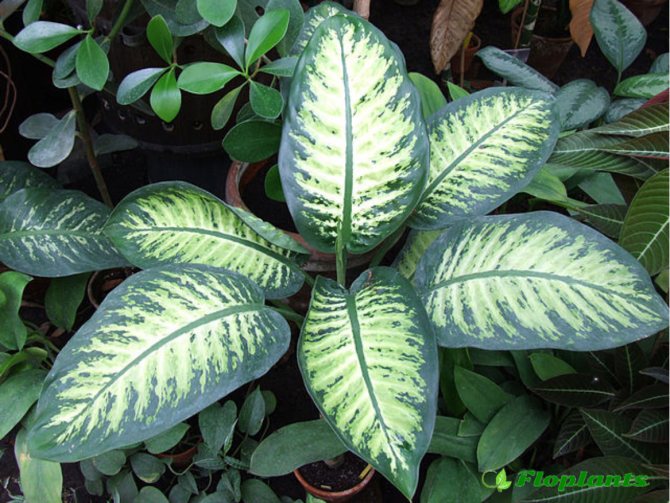
Dieffenbachia seguine.
This kind of plant, under favorable conditions, will surprise you with active growth, but do not expect flowering, at home this happens quite rarely. But all the same, Dieffenbachia is valued not for this, but for its large variegated leaves.
Dieffenbachia is quite poisonous and should not be neglected in terms of safety when working with it. Take seriously when choosing a place to grow it. If poison comes into contact with mucous membranes and skin, it can cause allergies or dermatitis. When it gets on the mucous membranes of the mouth, it causes swelling of the mucous membranes and salivary glands due to which a person loses the ability to speak, therefore, in the homeland of this plant, she received the nickname "dumb rod". The local population in the growing area of Dieffenbachia uses its juice as a means of fighting rodents and insects.
Dieffenbachia diseases
date of article: 11.01.2012
Dieffenbachia leaf spot.
Dieffenbachia leaf spot causes fungus Phaeosphaeria eustoma (Fuckel) L. Holm.
Signs of the disease. The lower, older leaves are most severely damaged, especially along the edge. Small round spots appear on the leaf blade of plants, growing as the disease progresses. The spots have a brown center and an orange border.
The pathogen remains on the remains of infected plants and is transmitted by water. Plants are more severely damaged if they are in high humidity and elevated temperatures.
Control measures. Maintaining optimal modes of air humidity and temperature of the content. When signs of disease appear, treatment with systemic fungicides is carried out.
Fusarium dieffenbachia.
Fusarium in Dieffenbachia is caused by a fungus Fusarium solani (Mart.) Sacc.
Signs of the disease. On the root collar and on the roots of the plant, elongated, depressed spots of dark shades appear. As a result of damage to the stems, yellowing and wilting of plants occurs. In the case of high humidity of the substrate and air, the damaged areas are covered with a light pink mycelium of the fungus.
The pathogen is able to persist in the soil for a long time, and it is very resistant to external influences.
The spread of the disease occurs with contaminated soil, as well as when the roots of a diseased and healthy plant come into contact.Plants with a lack of potassium in the substrate, as well as overdried plants, are especially susceptible to disease.
Control measures. Use of quality substrates. When cutting, only healthy material is used; it is recommended to immerse the cuttings in a fungicide solution for about 15 minutes for disinfection. For preventive purposes, spraying with biological fungicides is carried out, for example, Trichodermin (Glyocladin). If a disease is detected, plants are treated with systemic fungicides, for example, such as Rovral, Fundazol.
Dieffenbachia anthracnose.
Anthracnose in Dieffenbachia causes a fungus Colletotrichum gloeosporioides (Penz.) Penz. and Sacc.
Signs of the disease. Quite large spots appear on the leaves along the edge of the leaf blade. As the disease develops, the leaf dries out, since the spots spread to the entire surface of the leaf. The pathogen persists in infected plant debris.
Plants kept at high air temperatures and high air humidity are especially susceptible to the disease. Waterlogging of the substrate also contributes to the disease.
Control measures. Content, taking into account the characteristics of plant cultivation. When signs of a disease appear, treatment with systemic fungicides is carried out, for example, such as Vitaros, Fundazol.
Dieffenbachia root rot.
The causative agents of dieffenbachia root rot are types of fungi from the genera Pythium and Phytophthora.
Signs of the disease. Withering of the plant, followed by its death. On the root collar and on the roots of plants, depressed dark areas appear, as the disease develops, they cover the entire tissue, and in this place the plant rots, breaks and lays down. The mycelium of the fungus of a light gray color develops on the spots.
The pathogen remains in the soil, from where the infection of plants occurs.
Excess fertilizer in the substrate, lack of lighting, poor ventilation, excessive watering, too moisture-consuming substrates, high temperatures of the content - all these factors lead to the fact that the plant is more susceptible to damage by the pathogen. The difference in temperature between the substrate and the air, exceeding 6-8 ° C, also contributes to the development of rot.
Control measures. The use of high-quality, well-aerated substrates of a neutral reaction, correct agricultural technology, fertilizing with fertilizers with a high content of potassium. In case of signs of a disease, watering stops, the substrate is partially changed to a new, dry one, treatment is carried out with systemic fungicides, for example, such as Profit Gold, Ridomil Gold, Previkur.
Dieffenbachia bacteriosis.
Bacteriosis in Dieffenbachia is caused by species of bacteria Erwinia carotovora subsp. carotovora (Jones) Bergey et al and Erwinia chrisantemi Barras et al.
Signs of the disease. On the stems of the plant, both above and below the soil, watery spots appear with a sharply defined edge. After the spots become brown or gray. Watery spots also appear on the leaves, acquiring a light brown color and having a yellow border.
The pathogen remains in the remains of infected plants until they completely decompose, is transmitted with cuttings, in case of mechanical damage. The pathogen develops especially actively in conditions of high humidity and temperature, with an excess of nutrients in the soil. Oppressed plants are more severely damaged by this disease.
Control measures. Compliance with the regime of agricultural technology, the destruction of diseased plants, the use of clean tools for cutting plants.
Bronze of Dieffenbachia.
The causative agent of viral bronzing in dieffenbachia is Tomato spotted wilt virus.
Signs of the disease. The plant, on its leaves, appears concentric circles, ring-shaped spots, yellowish arcs. With the development of the disease, the leaves wilt, burn symptoms appear, unilateral necrosis of the leaves from the infected side of the stem is possible in the stems. The leaves remain hanging on the plant. The plant slows down growth processes.
Read also: Secrets of making drip irrigation from plastic bottles with your own hands
The pathogen is pest-borne. In particular, various species of the genus thrips.
Control measures. Timely treatment with insecticidal preparations.
Dieffenbachia mosaic.
Dieffenbachia causes viral mosaic Dasheen mosaic virus.
Signs of the disease. The growth processes of the plant slow down, a mosaic spot appears on the leaves.
The pathogen persists in infected plants, is transmitted by pests, mainly aphids, also with cuttings from diseased plants.
Control measures. Use for propagation of healthy plants, timely spraying of plants with insecticidal preparations.
In our article on Dieffenbachia, you can familiarize yourself with its cultivation, various types.
If you have problems with your Dieffenbachia, and you yourself cannot determine what is wrong with it, you can always contact us for help on our flower forum.
The article was prepared by: Marina and Alexander Mityaev
The following materials were used in the article:
Yordanka Stanchea, Boyan Rosnev. Atlas of Crop Diseases, Volume 5. Diseases of Ornamental and Forest Crops. Pensoft. Sofia-Moscow 2005
Reproduction of Dieffenbachia:
Anthurium propagates by apical cuttings, stem pieces, seeds.
Dieffenbachia is propagated most often by division into cuttings, which is carried out in the spring. The apical cuttings are cut, and the stem is cut into cuttings of 10 cm. The apical cuttings can be rooted both in water and in greenhouses under a film or bag in sand or a mixture of sand and peat. For fast rooting, you can use the drugs Kornevin, Zircon, Kornerost. The stump must be sprinkled with crushed coal and soon it will sprout new shoots and start branching. There are difficulties with the rooting of apical cuttings, they can rot. In this case, a new cut is made above and treated with a fungicide. Rooting in warm conditions takes place within a month.
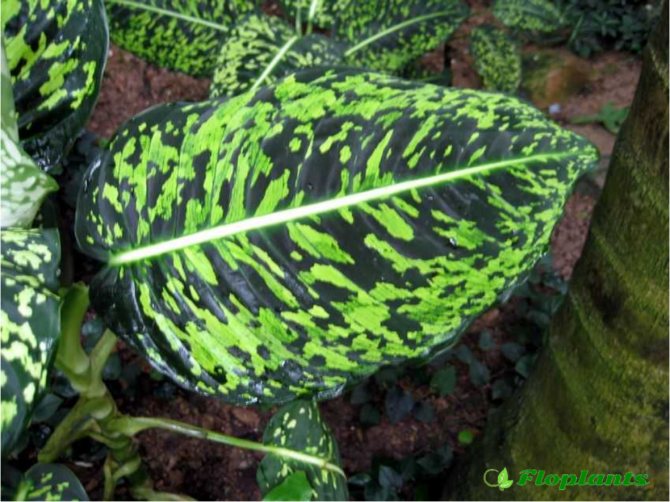

Dieffenbachia picta reflector
Stem pieces should be internodes, preferably 3-4. It is not advisable to plant immediately, it is better to let them dry for a couple of three days. Slices must be crushed with charcoal or sulfur. The cuttings must be well pressed into the substrate so that they only half peep out of the ground. With such reproduction, do not expect quick results, since the rooting and branching of a piece of the stem is a long process. It is necessary to water moderately and wait for the bud swells and the leaf appears. When this happened, you can fill up the earth or transplant the plant into a pot.
Seed propagation of Dieffenbachia is quite troublesome, since you yourself need to pollinate the flowers of the plant. Male and female flowers are scattered throughout the plant - female flowers are at the very bottom of the trunk, and male flowers are at the very top. In order to pollinate the flowers, you need to make a longitudinal incision on the flowering veil and introduce pollen from the same inflorescence there, and then seal the incision with tape. Flowering does not last long for a couple of days, after which it dries up. If the procedure is successful, then bright orange berries, which are poisonous, begin to ripen on the cob. They ripen for a very long time, up to six months. When fully ripe, the berries dry out and shrivel. The fruits are sown into chopped sphagnum moss.
Dieffenbachia ailments: how to help cope with them.
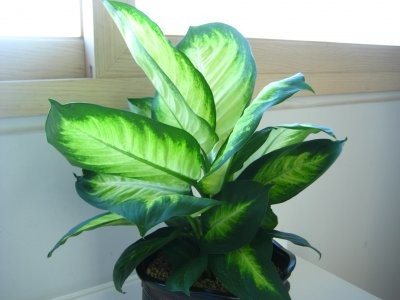

Dieffenbachia (Lat. Dieffenbachia) is an evergreen tropical plant native to the rainforests of Central and South America.
Dieffenbachia can reach two meters in height, the leaves are large, wide, variegated.
With good, competent care, Dieffenbachia pleases with its exotic beauty, the flower develops well, new leaves constantly appear on it. But what to do if your "green household" is sick?
Most often, growers growing Dieffenbachia are faced with the fact that its leaves begin to turn yellow, dry and curl, there are other problems - the flower grows poorly, becomes lethargic.
What is the cause of the ailment: improper home care or an attack of pests? Let's consider all the "sores" of Dieffenbachia in more detail and try to determine the cause of their occurrence and methods of treatment.
How to deal with aphids on Dieffenbachia
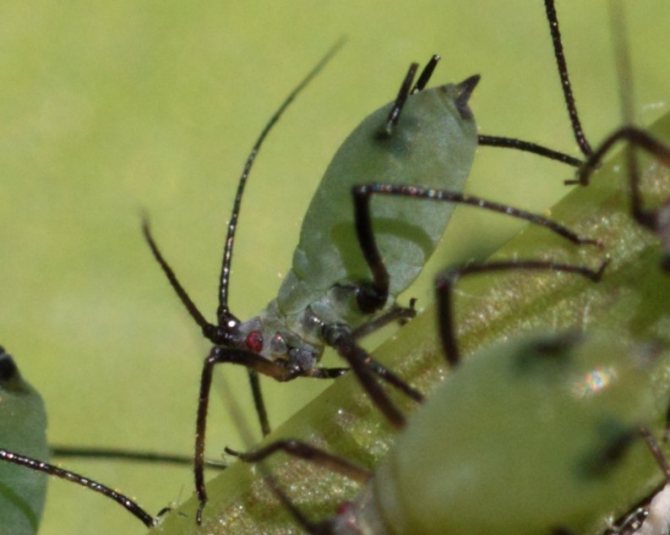

Aphids are especially harmful to flowers. The size of insects reaches two mm, females have no wings, males have. The color of pests can be very diverse: from light green to yellow, red or even pink.
Settling in large colonies on young leaves or sprouts, they suck out the juice from flowers, causing their deformation and transferring viral diseases.
Signs that aphids have attacked Dieffenbachia are the plant's loss of its original color, curling and shedding of leaves, as well as the presence of a sticky layer.
Important! In order to avoid poisoning children, it is necessary to place the flower in a hard-to-reach place.
To get rid of aphids, you need to remove it from the infected flower fragments by treating it with a solution of soapy water with kerosene, or by spraying the plant with a systemic insecticide.
If the flower is severely affected, then it is better to cut off the leaves and shoots. If necessary, repeat the treatment after 7-10 days.
Dieffenbachia diseases and their treatment
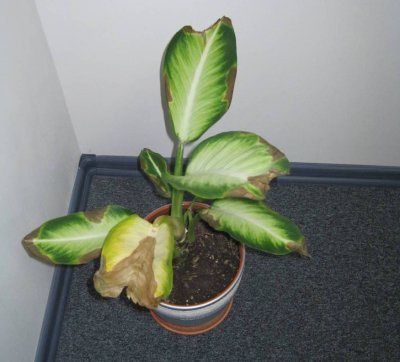

How to help a tropical beauty?
- Dieffenbachia leaves turn yellow, reasons, what to do? Solution to the problem:
- low air humidity. Dieffenbachia, not receiving enough moisture from the air, also begins to turn yellow, so in winter it should be kept away from central heating batteries or buy a humidifier;
- direct sunlight, there should be enough light;
In the photo below you will see the symptoms of the disease in Dieffenbachia:
The leaves of the dieffenbachia flower turn yellow. Reasons for what to do
Only an attentive and painstaking florist can save the pride of a home greenhouse. The fact is that it is necessary to analyze all possible sources of discomfort: from humidity and temperature to infectious agents and pests.
If Dieffenbachia is only a few days in the house (presented for a holiday or bought the other day), you should not sound the alarm. The flower has stress caused by an abrupt change in conditions. Amateur flower growers know that retail chains keep ornamental plants on stimulants until the moment of sale. After the purchase, the bush ceases to receive powerful doping. Not all flowers cope with this.
Not only dieffenbachia - any other plant from the store - goes through quarantine:
- The pot is placed separately, after examining it: they are looking for insects, spots of unknown origin.
- If threats to the health of the flower are detected, then they urgently change the soil and immediately pickle the plant.
- In the absence of suspicious results of examination with a transplant, you can endure a week watching the flower.
You will have to change the soil in any case. At home, decorators do not use potent flower stimulants. And from the planting soil, light and "empty", after 2-3 watering, the doping residues will be washed out. Starving Dieffenbachia will immediately respond with yellow leaves.
Another situation is also possible. An exotic from the tropics has been living in an apartment for a long time, and suddenly the florist noticed that the leaf plates turned pale, lost their dense color. After analyzing what has changed in the conditions of detention, it is easy to identify the probable cause. Therefore, before doing anything, when dieffenbachia leaves turn yellow one after another, you need to:
- carefully examine the plant: there are no traces of insects, foreign inclusions, softening of tissues, a putrid smell;
- check the dryness / moisture of the soil;
- make sure that when airing the room, dieffenbachia does not fall into the stream of through air movement;
- evaluate the lighting of foliage from windows;
- remember when the flower was last transplanted;
- restore, at least approximately, what and when the soil was fertilized.
Usually, the reasons for the discomfort of dieffenbachia are identified with such a simple analysis.
Natural drying of leaves
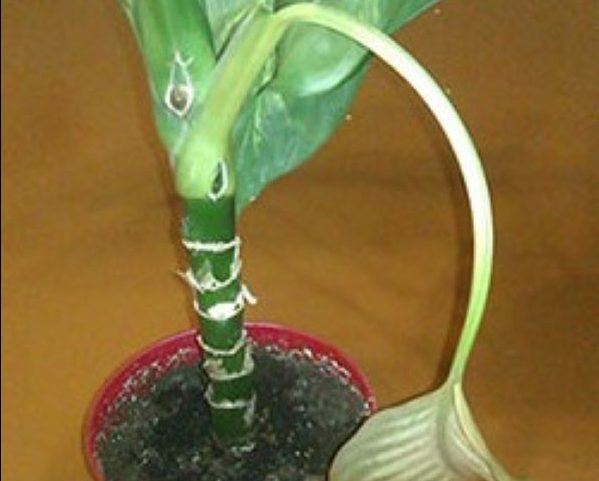

Dieffenbachia flower lower leaves turn yellow
If in an adult dieffenbachia it is the lower leaves that periodically turn yellow and dry out, there is no cause for alarm. This is a feature of the plant, which over time takes the form of a false palm: a high bare stem and a dense crown. Longer preservation of the decorative appearance of even aging dieffenbachia will help:
- timely transplantation into nutrient soil - at least 3-4 years;
- good lighting;
- compliance with the regime of watering and feeding.
If dieffenbachia is satisfied with everything, it will not stretch out and not be exposed ahead of time. Although the lower leaves will still periodically turn yellow, dry out and fall off.
Poor or excessively bright lighting
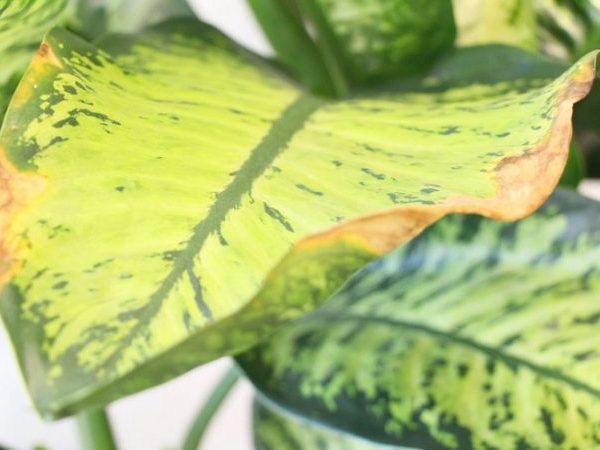

Dieffenbachia, leaves turn yellow due to lack of lighting
Dieffenbachia does not belong to plants for which the more light, the better. From an overabundance of the sun, especially direct rays, she suffers in the same way as from a deficiency. If, for the latter reason, the leaves of dieffenbachia discolor and turn yellow, the former even causes burns. The edges of the leaves can dry out and curl, and brown spots appear on the plates themselves. The fabrics dry out and fall asleep. The ability to photosynthesize is reduced. Dieffenbachia is wasting away.
In the summer, the flower pot is removed from the south side. Dieffenbachia is more comfortable next to the southeast or southwest window. If the room is oriented to the north, then on the windowsill it belongs to it: soft diffused light.
In winter, the day is shorter - Dieffenbachia sometimes lacks lighting. She begins to turn pale, stretches out. Leaves are smaller and less frequent. The stem bends towards the light source. In order not to spoil the beauty's appearance during the long winter, they turn on the cold light for 2-3 hours in the morning and in the evening.
Temperature violation
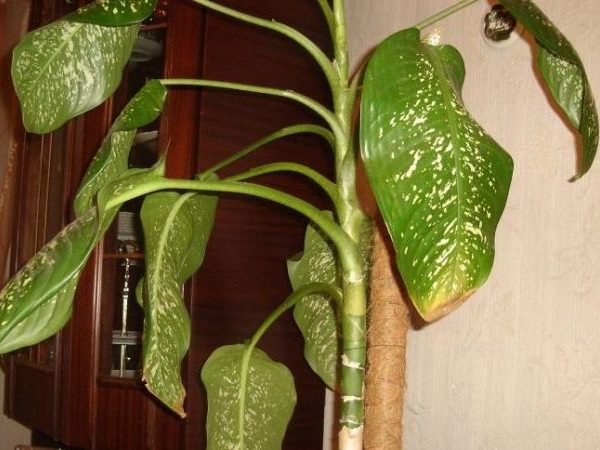

Dieffenbachia: leaf tips turn yellow and dry
Sharp changes in temperature from hot to cold happen in the off-season, when the radiators are turned on or, conversely, the central heating is turned off. Airing on a cold, windy day brings a stream of air into the room that contrasts with the home atmosphere.
If a flower hits the intersection of air currents of different temperatures or just stands in a draft, then, as a result, the tips of the leaves turn yellow first, dieffenbachia weakens, immunity falls. The previously bright plant fades, leaves leaves.
And if a sharp cold snap coincides with the overflow of soil, then there is a great danger of decay. Root disease is not noticeable until the plant is dug up. But the symptoms appear in the aerial part. The leaves are not just pale yellow. They may even become limp at the base. It is very difficult to save a flower in such a state.
Dry air
One of the most common reasons why the leaves of dieffenbachia begin to turn yellow and dry is dry air. This is a consequence of the operation of central heating radiators in winter and hot weather without precipitation in summer. In the hot season, regular irrigation is enough for the flower. During the period when the apartment is heated by hot batteries, the requirements for air humidity are higher. A couple of times a month, the tropical plant takes a warm shower with pleasure.
Important! They solve the problem of dry air and achieve a comfortable environment by placing the pot on a tray with water. But this does not mean that the flower stands in the water all the time - the planting container should not touch moisture. For this, expanded clay is first poured into the pallet, then a flowerpot is installed. Only after - water is poured. Instead of or together with expanded clay, sphagnum is used.
Improper watering
Everything is simple here. Forgotten dieffenbachia turns pale without watering, the greens are replaced by yellow. First, in dieffenbachia, the edges of the leaves turn yellow and dry. If you don't give it a drink on time, the plant will dry out. When the grower overdoes it with watering, the flower rots.The beginning of this process also begins with the yellowing of the leaf plates: they fade gradually, over several days, but completely - over the entire area.
They adjust the irrigation regime by touch: by lowering your finger into the ground, they determine at what depth the ground is already dry. If the soil freely passes a finger over a whole phalanx without sticking to the skin, then it's time to water.
Cramped pot
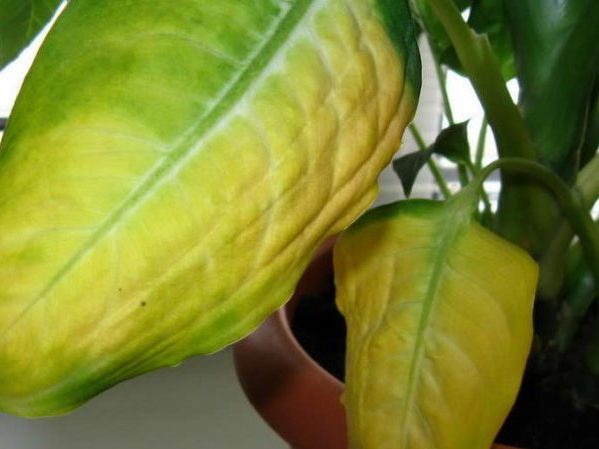

Dieffenbachia flower leaves turn yellow
The plant loses its color if the root system has filled the entire container, displacing the earth. There are no reserves left for development - dieffenbachia signals a problem with the fading of the once bright greenery.
To make sure that it is time to change the volume and renew the soil, you can lift the plant, firmly grasping it by the base of the stem. Not an earthen ball will rise from the pot, but a ball of intertwined roots. The lower processes are taken out of the cramped dishes through the drainage holes.
Incorrectly selected soil
It is difficult to live in the heavy soil of Dieffenbachia - you cannot just dig up garden soil and plant a flower. Ground requirements:
- lightness, air and moisture permeability;
- reaction - 5.6;
- in the composition - sand and peat;
- charcoal is required.
The self-assembled substrate is prepared on the basis of leafy soil with the indicated components. Humus will also add nutritional value.
Excess or lack of nutrition
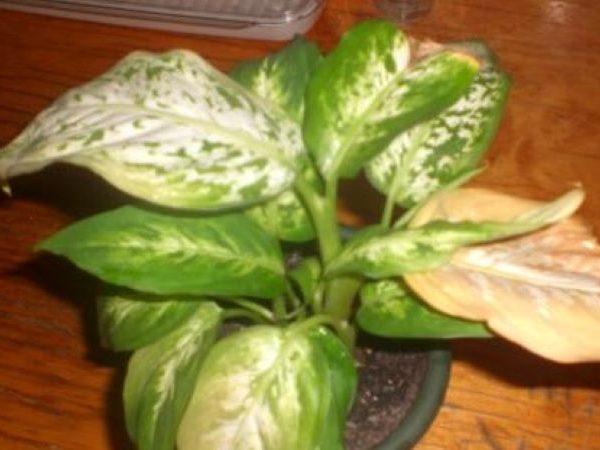

The leaves of the diffinbachia flower turn yellow, the reason is a lack of nutrition
Violation of the fertilization schedule first of all affects the color of the foliage. Overfeeding is even more dangerous than a small deficiency: it is difficult to wash out excess nutrients from the substrate. It takes time. While the soil is rinsed out, the plant will be poisoned. Therefore, if an overdose occurs, it is easier to transplant dieffenbachia into a new soil mixture.
Top dressing rules:
- After planting in a new nutrient soil - not earlier than after 1-1.5 months.
- April - September: every 13-15 days.
- October - March: rest.
Choose a complex remedy for plants with decorative leaves.
If dieffenbachia leaves the edges of the leaves turn yellow after fertilization - the contour becomes dry and brittle - we are talking about an overdose. Deficiency often manifests itself as discoloration from the center along the veins or web between them.
Diseases
In the absence of other probable reasons for the yellowness of the leaves, there is only one conclusion - dieffenbachia is ill. It is better to immediately transplant into new soil, having previously examined the roots, treating them with a fungicide.
Pest infestation
Yellow spots, sticky surfaces, brown plaques, white fluff, dusty cobwebs are visible manifestations that insects have settled on Dieffenbachia.
Ambulance:
- With a cotton pad dipped in water from the household. wipe all the leaves and trunk with soap from the top to the base.
- Remove too damaged leaves.
- Treat with insecticide. If a tick is found, then spray it with acaricide.
- Repeat the treatment every 5-6 days for a month.
All potted neighbors are subject to inspection and prophylactic etching.
Pests. Methods of dealing with them
Despite its poisonous nature, Dieffenbachia is susceptible to pest attacks that cause significant harm to it.
Spider mites, aphids, mealybugs, scale insects are most often affected. The method of dealing with each species is the same: it is necessary to wash the leaves and the stem of the flower with a sponge moistened with soapy water (which later needs to be washed off under a stream of warm water) and treatment of Dieffenbachia with an insecticide solution (malofos, 15 drops per 1 liter of water).
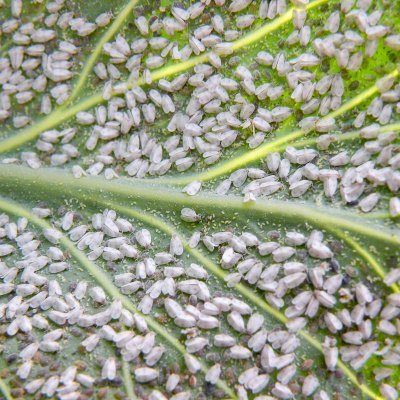

Ways to deal with spider mites
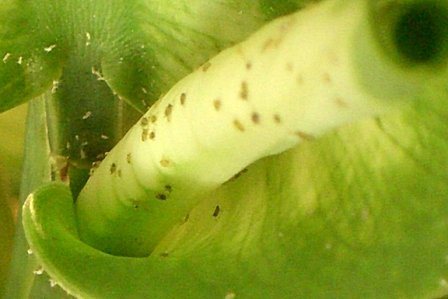

If you see that dieffenbachia is covered with cobwebs, this is the first symptom of a spider mite. Tick sizes vary from 0.3 to 0.5 mm, females are purple-red, males are bright red.
Dry, warm rooms serve as a favorable environment for its habitat, which is why it is dangerous all year round, being located on the back of the leaf. Dieffenbachia leaves infected with spider mites turn yellow and dry out.
These pests are also insidious in that when unfavorable conditions for their reproduction occur, the female can burrow into the ground and fall into a state of dormancy, before the onset of conditions suitable for life processes.
One female tick lays up to 150 eggs at a time. As soon as you notice that dieffenbachia is in the web, immediately begin to act, since one female can lay 8-10 generations of eggs over the summer.
If the flower is not severely affected, you can wash its shoots and leaves with a solution of soapy water or an aqueous tincture of garlic. In case of intense damage, you need to use insecticides, or colloidal sulfur.
Important! If the juice of a flower gets on the skin, you must immediately wash it off with soap and water, since it is very poisonous.
Dieffenbachia diseases: how to help a tropical beauty
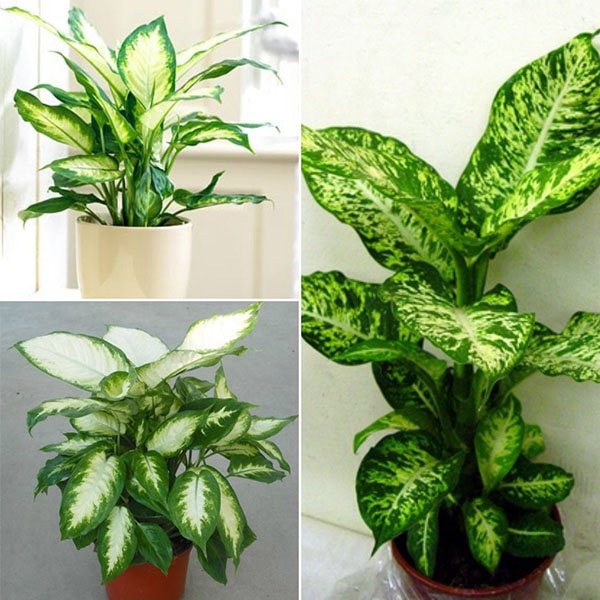

Fans of lush houseplants often admire dieffenbachia, a guest of their America's humid forests. This cute flower can grow up to 2 meters in height, decorating a living space. Wide leaf plates of green color are decorated with variegated patterns, from which it is impossible to look away. They are amazing, but unfortunately, various diseases of Dieffenbachia bring a lot of grief to their masters.
Careful plant maintenance contributes to the successful development of dieffenbachia, as a result of which new leaves appear on it regularly. What to do if a tropical beauty gets sick? How to help a silent “household”? First of all, it is important to gain knowledge, and only then take action.
According to experts, dieffenbachia is considered a poisonous plant. If it gets on the mucous part of the body, its juice causes irritation and even allergies. It is especially dangerous for children.
Why does dieffenbachia form droplets on the leaves
Such an unusual phenomenon is called Gutta (gutta - drop), and consists in the release of droplet liquid by the leaves of the plant in order to release excess water and various mineral salts.
Also read: Coleria: flower varieties, cultivation and care features
In addition to too abundant and frequent irrigation measures, guttation can increase in conditions of a decrease in atmospheric pressure. Along with other aroids, Dieffenbachia juice is poisonousTherefore, it is not recommended to touch the droplets that actively stand out on the surface of the leaf plates. Over time, they dry out on their own.
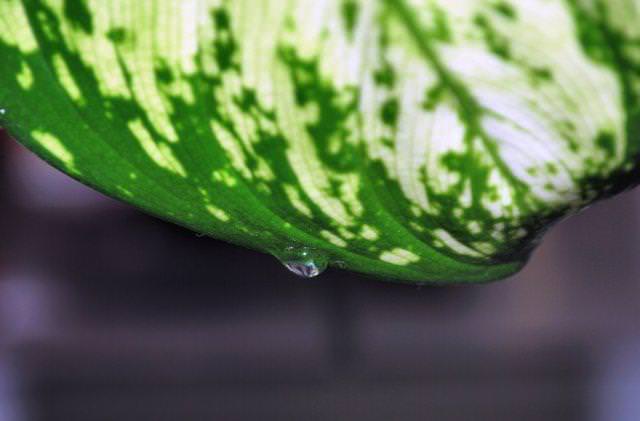

Dieffenbachia diseases: general information
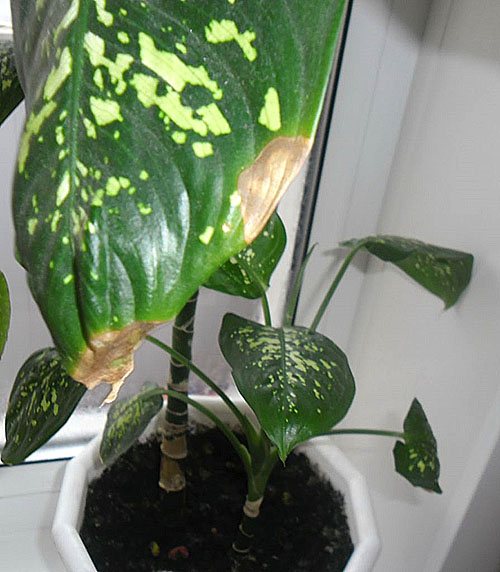

Quite often, lovers of indoor flowers notice how the leaves of a tropical beauty turn yellow. The first thing that comes to mind is the wrong care. But this happens even with the most dedicated flower growers. Dieffenbachia diseases occur for various reasons, the main thing is to start treatment on time.
Another problem of the plant is drying and dropping of the lower leaf plates. Since they are the main decoration of the flower, it is not very pleasant to watch their loss. In some cases, the reason is the natural process of plant development, which even the most competent florist cannot stop. But if young plates fall off, it is worth thinking about the possible dieffenbachia disease and the methods of timely treatment.
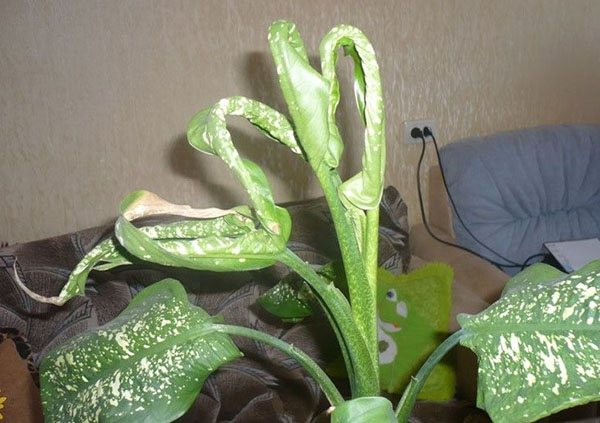

Quite an unpleasant sight when a beloved flower drops the once lush leaves and takes on a miserable look. Dieffenbachia withers for various reasons, but this appearance is a signal for action. In addition, the plant may develop brown spots, droplets of unknown origin, or even non-expanding leaves. Let us consider in detail the possible causes and methods of treating dieffenbachia diseases.
If small children live in the house, an exotic flower can be brought in the office. Such a cute "neighbor" will decorate the room with lush greenery and will always be a reason for joy.
Harm and benefit
A large and showy dieffenbachia flower can be a wonderful living decoration for the office, but not always for the home. It is dangerous to keep the plant where there are nosy little children or pets in families. If a leaf gets into their mouth, it will cause swelling of the tongue and throat, which will lead to temporary loss of speech for some and voice for others. Although this reaction usually goes away quickly (within a few days), it can lead to suffocation. This is why you cannot keep Dieffenbachia at home when there are babies or animals in the house..
Its leaves contain two dangerous components: oxalic acid and the amino acid asparagine. Poisoning symptoms in children:
- Burning sensation in the throat and mouth;
- Hoarse voice;
- Nausea and vomiting;
- Swelling and blisters on the tongue and oral mucosa;
- Impaired speech and swallowing;
- Pain and irritation in the eyes.
First aid for children: wipe your mouth with a cold, damp cloth; rinse your eyes; give milk to drink; Call a doctor.
Without babies and pets in the house, the dieffenbachia flower is not dangerous if you wear gloves while working with it or wash your hands with soap at the end, since when the plant sap comes into contact with the skin, a rash or itching may appear.
If we talk about the benefits: dieffenbachia camilla, variegated (painted), adorable (pleasant), gorgeous, large-leaved, dieffenbachia spotted or any other species of the family is called a fountain plant. They are able to absorb all types of pollutants from indoor air, including toxins (benzene, formaldehyde).
Brown spots on leaves: causes and methods of struggle
The main causes of the disease are caused by such factors:
- high room temperature;
- drops in humidity;
- excessive watering of the plant.
If the rules of care are followed and the listed points are not observed, then the plant is affected by a serious disease:
With such problems, brown spots appear on the leaves, framed by a dark line. A fungicide solution, which should be sprayed with an infected plant, will help get rid of the disease.
In order for Dieffenbachia to get enough moisture from the air, it must be "settled" away from direct sunlight, and in the cold season, from central heating.
The best option for growing dieffenbachia is the east side of an apartment or house. Away from the sun, which burns its delicate leaves.
Incorrectly selected lighting
The appearance of spots on the leaves of a culture is associated with the ingress of a large amount of sunlight or, conversely, with their insufficiency. In dark places, the color of the leaves becomes faded and more green, which impairs their decorative appearance. If you find dieffenbachia near a window overlooking the sunny side, the leaves can burn.
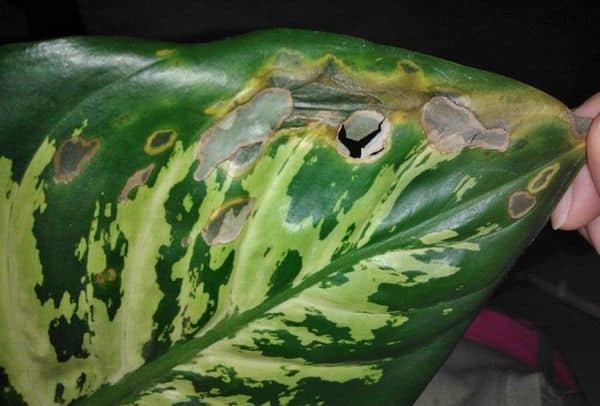

The plant requires diffused lighting. Damaged leaves cannot be restored, so they must be carefully removed with a pruner. After that, the plant should be rearranged to a bright place, but without direct sunlight on the crop.
Leaf plates do not open: a wise solution to the problem
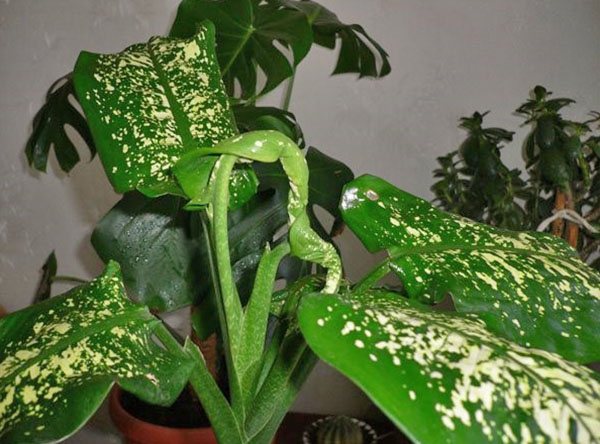

For several decades, Dieffenbachia has gained particular popularity. It can be found in the corridors of clinics and hospitals, offices, educational institutions and even train stations. The main reason is simple care, which consists of such activities:
- regular soil moistening;
- spraying leaf plates;
- growing a plant away from drafts;
- room temperature control;
- the right choice of habitat (away from direct rays of the sun).
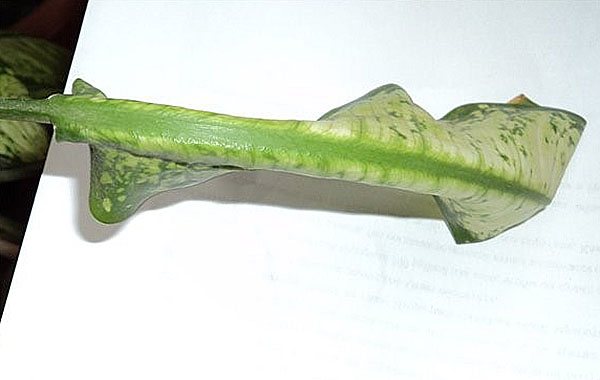

Despite this, the plant can get sick. Sometimes it happens that the leaves of dieffenbachia do not open, as a result of which its beauty is lost. Often the reason lies in the following factors:
- direct sunlight falls on it;
- drafts that lead to sudden changes in temperature;
- rotting roots due to excessive moisture;
- low level of humidity in the room;
- lack of useful elements.
Damage to the plant by pests such as spider mites, mealybugs, aphids or scale insects should not be ruled out. If "enemies" are found, the flower should be treated with soapy water. If it does not help, apply insecticides.
Watering
To maintain the life of dieffenbachia, it is required to observe the volume of water added to the ground. The plant begins to die with an excess of moisture. The roots and trunk of the plant are fleshy, in which the process of decay begins when waterlogged. You can see the beginning of decay on the lower leaves of the bush - they begin to turn yellow.
Watering the plant correctly:
- After each watering, you must wait for the first layer of soil to dry out.
- For humidification, it is required to add settled water at room temperature. When cold is added, the process of root rotting begins.
- After watering, you need to wait a little, then pour out the remaining water from the pan to avoid damage to the root system.
- Watering is required abundantly, but only after the surface of the earth has dried. You can check it for moisture with your hand or a stick.
An excess of moisture forms a green bloom on the ground, and it becomes mucus.
Dieffenbachia "cries" and does not grow
Sometimes the following factors influence the growth of dieffenbachia:
- lack of light;
- "Drought" on the soil;
- the need for feeding.
An attentive attitude to the flower and simple actions will help to eliminate problems:
- moving to another place in the room;
- regular moistening of the topsoil;
- the use of special fertilizers for dieffenbachia.
Unfortunately, each of us tends to go to extremes. Therefore, excessive watering can lead to root rot and the appearance of a drop on dieffenbachia. It is interesting that in such an extraordinary way, the flower compensates for the excess moisture. Such droplets on the leaves are also found during the period of heavy rains. This is how the plant protects itself from excess fluid.
Another reason for the appearance of wateriness on leaf plates is bacteriosis. Small droplets of moisture may not be alarming at first, but if they are outlined with a visible border, it's time to sound the alarm. Subsequently, the foliage becomes brown and dies. It is better to destroy such a plant in order to prevent the spread of the disease to other indoor flowers.
How to reproduce?
- In spring and summer, it is necessary to pinch off the top, then root it in moist sand. The stalk is covered with plastic wrap, sometimes ventilated.
- Another way is possible - an incision is made on the stem 0.5 cm lower than the leaf, a wet match is placed there, which is sprinkled with a special powder for rooting plants. After that it is covered with wet moss, then with a film. After 3-4 months, roots germinate through the moss. It is necessary to cut the stalk below the roots and plant in a pot 10-12 cm in diameter. The remaining part of the stalk must be divided into parts so that each has 1 dormant bud. The resulting sections are sprinkled with charcoal and then dried. Then the cuttings are rooted, planting them half in the ground, they are covered with a film or a jar.
Caution - Dieffenbachia!
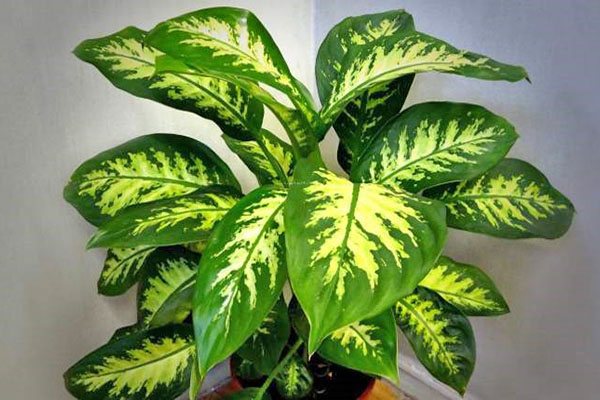

Despite its attractiveness, the cute tropical beauty belongs to the poisonous plants. The sap secreted by the plant causes minor damage to the skin. But if it gets on the mucous tissue of the mouth or eyes, a burn occurs. In rare cases, complete intoxication of the body can occur, which manifests itself as follows:
- swelling of the mouth tissues and lips;
- profuse salivation;
- rapid breathing;
- vomiting;
- diarrhea;
- temperature increase;
- tearing.
First aid for dieffenbachy burns, and treatment consists of simple steps. First you need to rinse the affected skin area with running water. For painful sensations, a solution of lidocaine is applied to the burn. If the juice gets on the eyeball, then wash the affected eye with running water for about 20 minutes. Then use drops "Levomycetin" or a solution of furacilin to prevent infection.
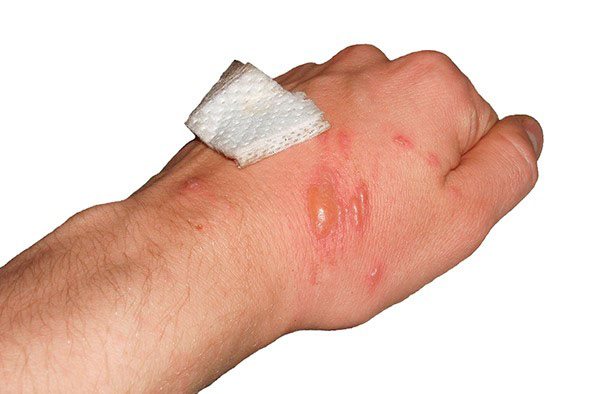

Burns resulting from dieffenbachia juice in the oral cavity are removed thanks to the rinsing procedure. A clearly expressed pain can be quenched with a solution of novocaine (0.5%). After these steps, it is recommended to drink a glass of cold milk or water. In any case, when a problem arises, it is important not to waste time, but to act.
Why dieffenbachia turns yellow - video
When and how to transplant?
Since dieffenbachia grows very quickly, it is necessary to transplant it every year in the spring. This is done, trying to prevent the earth from crumbling from the roots. A new pot is chosen slightly larger in diameter than the previous one.
If you buy a larger pot, when planting a plant, the soil where the roots do not reach oxidizes, and dieffenbachia may die
Step-by-step instruction
- A young plant grows very quickly, because of this, it needs to be replanted annually in the spring. First, make the ground from 2 parts turf, 1 part peat, 1 part humus and 0.5 part sand.
- The new pot should be 2 cm larger than the previous one. There should be drainage holes at the bottom of the pot.
- Put broken shards, pebbles, expanded clay at the bottom. After that, add a little earth and cross the plant, being careful not to destroy the clod of earth. Then pour abundantly with warm, settled water.
Fungal diseases
Dieffenbachia, which belongs to tropical ornamental crops, is often subject to fungal diseases. The main reasons are high humidity and high room temperature, as well as excessive watering. If you notice that dieffenbachia has stopped in growth and development, has begun to wither, turn yellow, bend to the ground or dry, reconsider the growing conditions and the peculiarities of caring for an indoor flower.
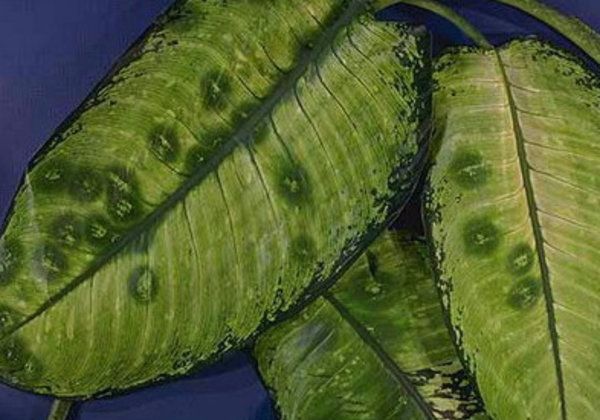

Fusarium is caused by fungi of the genus Fusarium solani and appears as dark, depressed spots on the roots and root collar of Dieffenbachia. As a result of damage to the root system, the leaves begin to turn yellow, turn in the opposite direction and wither. In this case, the damaged areas are covered with a pinkish mycelium of the fungus. In order to prevent fusarium, you can use "Glyocladin" and "Trichodermin", but with an abundance
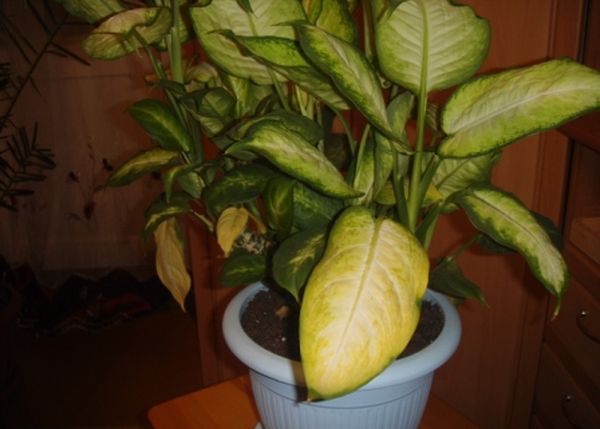

Leaf spot
Phaeosphaeria eustoma fungi provoke the development of leaf spot in Dieffenbachia. Fungal spores are carried by infected plants and also by water. The main signs of the disease are considered to be a small brown drop with bright orange edges on the leaves of an indoor flower.
The disease develops rapidly, the spots increase in size and cover an ever larger area of the leaf plate. To cope with leaf spot, you need to maintain an optimal temperature regime in the room and an appropriate air humidity. At the first symptoms, it is recommended to treat indoor flowers with "Fundazol" or "Vitaros".
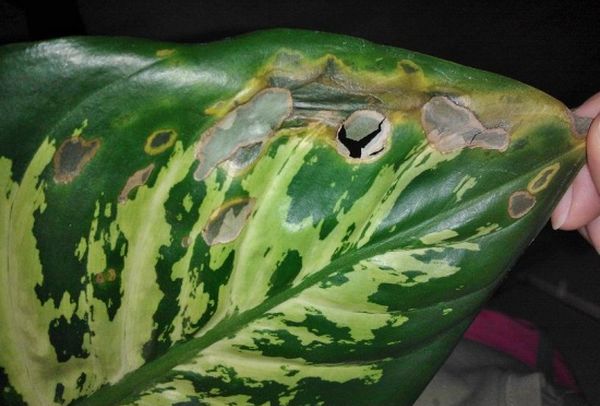

Root rot
Root rot pathogens are Pythium and Phytophthora fungi. It is almost impossible to detect the disease at the initial stage, since the causative agents of fungal infection affect the root and root neck of dieffenbachia. In the lower part of the trunk, brown spots are formed, covered with a pale gray mycelium. As a result of rotting, the trunk gradually breaks and the flower begins to fall off.
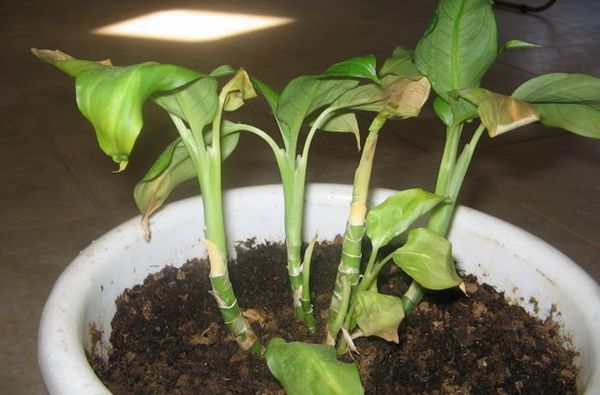

Sometimes dieffenbachia suffers from bacteriosis, which manifests itself in the form of watery spots with clear boundaries of a gray or brown hue. In this case, not only the aboveground, but also the underground part of the plant trunk suffers. Over time, gray-brown watery spots begin to appear on the leaves.
The causative agents of bacteriosis remain in the fragments of previously infected plants, and are also transmitted during mechanical damage to indoor flowers.
Unfortunately, bacteriosis refers to bacterial ailments, which are almost impossible to cope with.In case of damage to a houseplant by pathogens of this disease, it is necessary to treat the flower with copper sulfate or Bordeaux liquid, after removing the damaged leaves and branches. Observe the farming regime and always work with clean tools.
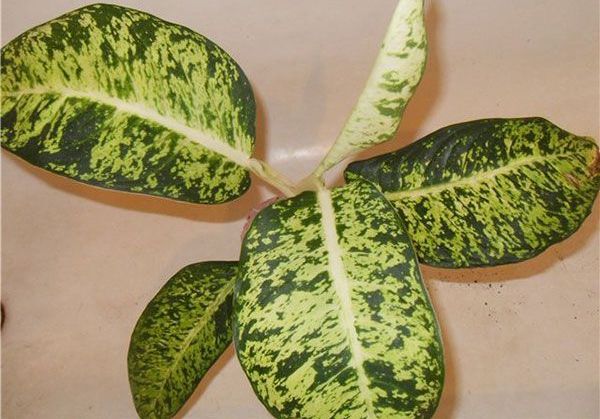

Reproduction
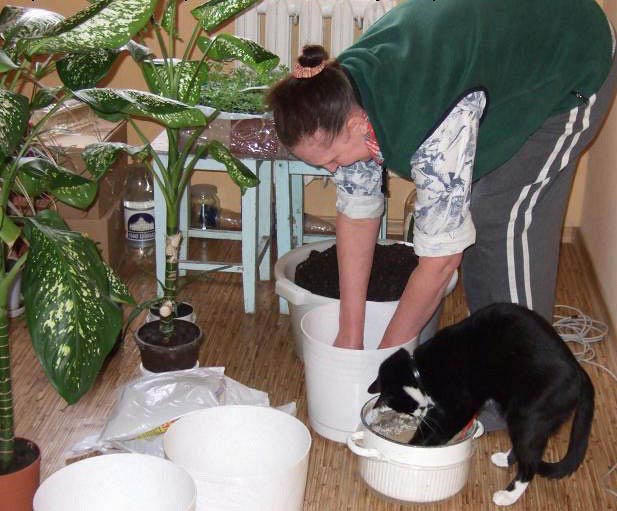

After pruning dieffenbachia, reproduction takes place with the help of cuttings and tops. Before rooting, the cut is dried for a day, and then placed in a small amount of water (with two tablets of activated carbon) so that only the two lower nodes are immersed. Roots appear in 2-3 weeks. During the rooting of the apex, its leaves often droop. This is due to stress. In this case, the stem is placed for a while in a basin of water (as we do with roses).
Young plants are planted in small pots, about 15 cm in diameter.
Let's talk in detail how to propagate dieffenbachia using cuttings.
First method:
- the cut off bare trunk is cut into small cuttings (5–7 cm);
- poured into a container of earth or sand;
- cuttings are laid out on the surface, without sprinkling them, and watered.
Second method:
- the cut cuttings are laid out in a horizontal position in a container with earth, slightly dripping them:
- sprayed from a spray bottle and covered with a plastic bag, creating greenhouse conditions inside;
- the container is placed in a warm place so that the buds begin to germinate. Further care is to keep the soil moist. For this, it is not watered, but only sprayed.
Viral diseases
To answer the question of why dieffenbachia leaves turn yellow, one should not exclude the possibility of a viral disease. Even with proper care, tropical ornamental crops often suffer from leaf bronzing and viral mosaics.
Bronze of leaves
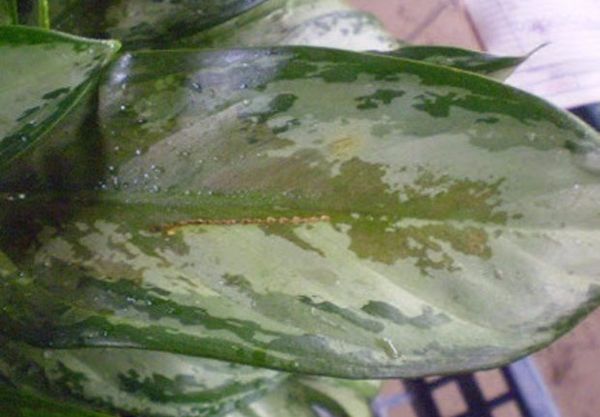

Viral mosaic
The Dasheen mosaic virus is the cause of the occurrence of such an ailment in exotic dieffenbachia as viral mosaic. The main symptoms of this ailment include the suspension of growth processes and the presence of mosaic spotting on the surface of the leaves. The pathogen of the disease is carried by cuttings or insect pests (in particular, aphids), and also persists in previously infected houseplants.
And now we will learn how to deal with viral infections, due to which dieffenbachia can turn yellow, wither, shed leaves and rot. In the fight against viruses that quickly infect the stems and leaves of indoor plants, you need to act urgently. Modern preparations of insecticidal action will come to the rescue, among which "Aktara" and "Fitoverm" are very popular among gardeners.
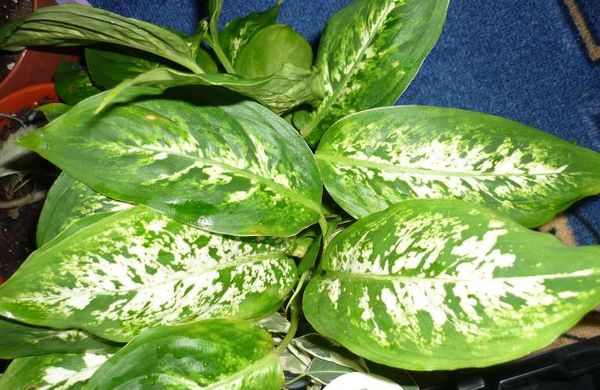

Curling and drying leaves, how to protect dieffenbachia from thrips
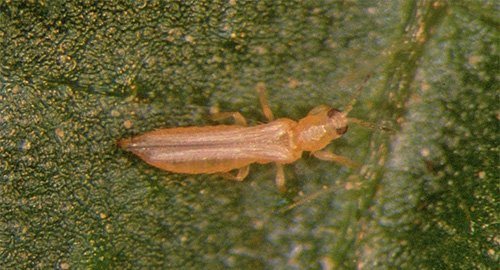

One of the many pests dangerous for diphenbachia are thrips, since temperature fluctuations do not affect their reproduction.
The body of the thrips is narrow with two pairs of wings, 1.5 mm long. The color of thrips is black or brown, the larvae are yellow.
Dieffenbachia affected by thrips is discolored and covered with gray spots. Soon the leaves turn brown and crumble.
These sucking pests (both adults and larvae) cause the main damage to peduncles, which are covered with stains and distorted.
In addition, the plant is covered with a sticky black substance, which can grow sooty fungus. To combat this type of insect, the use of flycatchers and spraying with insecticides will be effective.
Did you know? Dieffenbachia got its name in honor of the German botanist J. F. Dieffenbach.
The appearance of pests
The causes of yellowed foliage in a flower can also be caused by pests. Some of them feed on leaves, others suck the sap from the plant along with nutrients. Mass reproduction of pests can lead to the death of a room crop.
Aphid
It is a small sucking insect that is difficult to spot. It lives on the lower leaf plate. It looks like a small black or green dot. It happens with or without wings. It feeds on plant juices. The first symptoms of the presence of an insect are immediately reflected in the foliage. At first, it turns yellow, and then curls and falls off. With a strong infection, the plant dies.
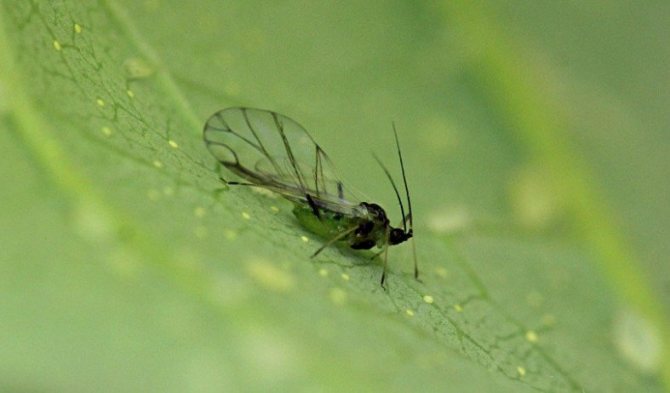

With a slight spread of pests, it is necessary to treat the ground part of the plant with soapy water. In advanced cases, treatment with "Akarin", "Inta-Vir", "Fufanon", "Fitoverm", "Aktara" (these are insecticides) will be required.
Important! The reasons why the lower leaves turn yellow in dieffenbachia cannot always be the owner's mistake, the development of the disease or the defeat of the pest. Most often this happens for a natural reason - the formation of the stem and shedding of old foliage.
Shield
The scabbard can be found on the stem. It is a small insect with a shell. Just like aphids, it sucks the sap from the plant. The scale insect appears on plants with weakened immunity, which are not properly fed, grow in soil with an excess of nitrogen, in the absence of proper care. Infection occurs from plant to plant.
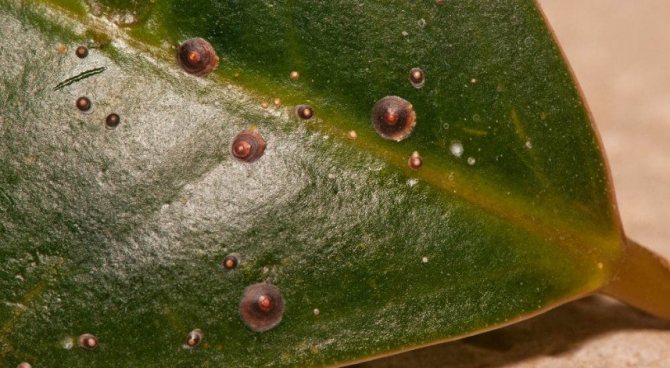

The first symptoms of the appearance of a scale insect are a sticky liquid on the trunk. Destroy it by scraping with a brush. Efficient and vinegar rubdown, rubbing with tincture of garlic, red pepper. In case of severe infection, they resort to chemical treatment using Fitoverm, Aktellik, Metaphos.
Thrips
Thrips are small insects with 2 wings up to 2 mm in size, black, brown or yellow. The fact that these parasites have chosen the plant is indicated by small holes on the leaves, brown spots, and deformation of the stems. Dry air and the lack of spraying contribute to their reproduction. The flower is treated with insecticides "Aktellik", "Inta-Vir", "Fitoverm", "Aktara".
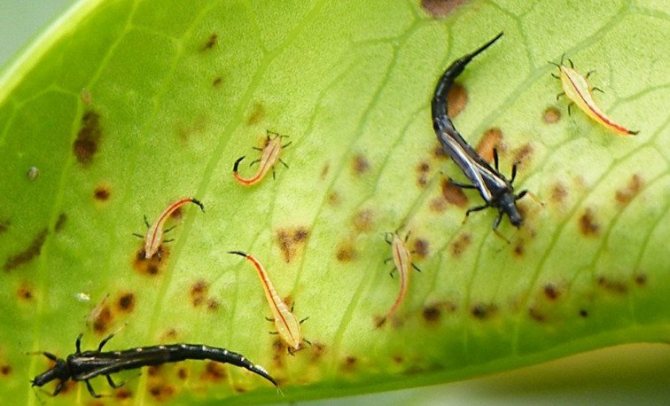

Mealybug
A characteristic sign of a mealybug lesion is white, cotton-like discharge on the stem, leaves, and shoots. These parasites, feeding on the juices of the flower, negatively affect its growth, development and decorativeness. Pests are easy to spot on the plant - they move quickly, covered with a white coating. The parasite appears on plants growing at temperatures above +25 ° C and high humidity. Waterlogging of the soil contributes to its development.
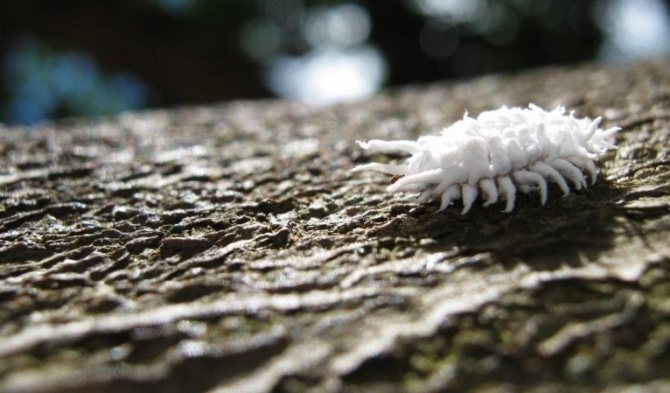

Infection occurs precisely through the soil. The worms are removed by wiping the leaves with soapy water, cyclamen broth, garlic, tobacco infusions. In case of severe infection, they resort to the use of insecticides - "Aktara", "Confidora", "Fitoverma", "Biotlin".
Spider mite
The presence of a spider mite is indicated by the presence of a cobweb on the stem and leaves. The mite itself can be found on the lower leaf plate. It looks like a small black dot. Since this harmful insect does not like coolness and high humidity, but dry air and heat provoke its appearance, one of the ways to combat it is to spray the plant and put a plastic bag on it for several days.
Did you know? In the United States, dieffenbachia juice was used to punish slaves. It was enough to chew the leaf petiole, and the slave suffered paralysis of the facial muscles.
—
he could neither eat nor speak. For its properties, the plant received the name
«
dumb rods
».
After this time, the insect will die. They also fight the tick with soap rubdowns, with the help of Fitoverm, Bi-58, Karate, Iskra-M, Aktellik.
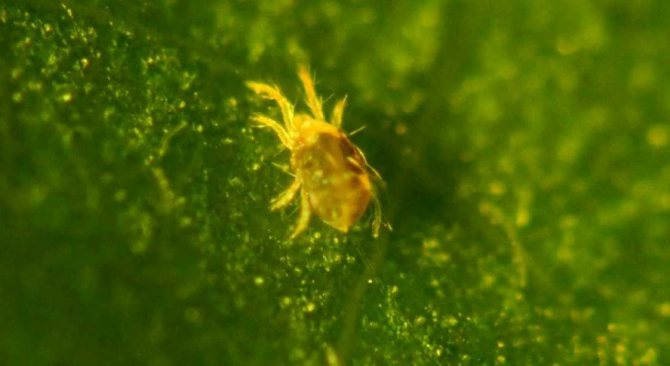

Strong hydration
In case of decay, dieffenbachia, an emergency transplant and a decrease in watering are neededand sometimes it doesn't help either. We have to cut off and root the surviving tops.
To protect the plant from decay, it is necessary to strictly observe its watering regime. You can not fill the flower, but you should not overdry the earthen lump, as this can cause the death of the plant.Keeping the soil moist but not wet is easy enough. Watering is carried out only after the top layer of soil in the pot has dried to a depth of 2-3 cm.
Sometimes plants turn yellow as a result of root rot and with the correct watering regime. This happens when the soil composition is incorrectly selected. Dieffenbachia soil should be light. In heavy soils, water stagnation and root decay are possible.
Features of temperature and humidity for successful growth
Dieffenbachia, among other things, is a heat-loving plant, so if you notice that the tips of the leaves turn yellow, pay attention to the temperature regime. At low temperatures, dieffenbachia sheds leaves, which dry out and turn yellow beforehand.
In this case, everything is simple: you just need to rearrange the plant in a warmer place. Another enemy of dieffenbachia is dry air. In this case, the leaves also turn yellow and dry out. The best solution is to install a humidifier, but if this option does not suit you, then it will be enough just to regularly spray the leaves and air around the plant.
Types and varieties with photos
In nature, there are about 50 types of dieffenbachia, but only a third of the total number of plants is suitable for growing at home. They, in turn, differ in the shape, size and color of the plant. Today, there are a large number of new varieties and hybrids, which sometimes do not fit any specific description.
Spotted or Painted
The most popular type of dieffenbachia is Spotted or Painted, it is also the ancestor of other species of this plant. It includes 17 different varieties, such as: Camilla, Compact and others.
Spotted Dieffenbachia has a large green trunk. The stem grows 40-45 centimeters in height in one year. Reaching one meter, plant growth stops.
The leaves are 45-50 centimeters long and 13-15 centimeters wide. Oblong, green leaves pointed at the edges. The pattern on the leaves combines irregular white and yellowish spots and clear stripes. The foliage is rough, smooth, or covered with raised patterns to the touch. The surface is glossy or matt. In indoor conditions, dieffenbachia rarely blooms. If this happened, then white-yellow, small flowers are practically invisible against the background of leaves. The flower pot should be placed at some distance from the window.
The most common color is marble. It can be identified by color transitions from pale green to dark green shades. These include the Bauze and Bauman hybrids.
You can also find a different color, when the leaf in the middle is colorless (due to the absence of chlorophyll), and the edges are painted with a contrasting color.
The Mars variety is a species of Spotted Dieffenbachia. The leaves are dark green, decorated with a marbled light pattern of dots and strokes, merging into a general tone. The variety does not react well to organic fertilizers and drafts.
Dieffenbachia Maroba
Dieffenbachia Maroba is similar in color to Mars, but has wide, slightly ribbed, shiny leaves.
Dieffenbachia Seguin
Dieffenbachia Seguin is considered a common species. It is a bushy species with large, wide, dark green foliage with dull yellow toothed streaks in the middle of the leaf and a small number of veins. In comparison with spotted dieffenbachia, the foliage of this species is smaller. There are few lateral veins. The petioles are shortened.
This species is used for breeding new varieties, hybrids, such as: Tropic Snow, Green Magic.
Tropic Snow
Tropic Snow grows up to 80 centimeters in height. The leaves have large white spots.
Green Magic
A distinctive feature of the Green Magic variety is a bright white central vein on the leaf and a dark green background. It is often supplemented with light, thin lateral veins. The background is smooth, without splashes. The leaves are shiny, dense, large in size.The shape is almost oval, with a slight sharpening.
Dieffenbachia Mix
Dieffenbachia Mix is a common bush species. This is a stunted species with a variety of foliage colors. The basic tone of the leaf is light green.
Dieffenbachia bush
Dieffenbachia bush belongs to one of the most unpretentious representatives. The flower grows up to 70 centimeters. The foliage is light green. A large white vein is visible in the middle. Externally, the flower is similar to Leopold's Dieffenbachia.
Dieffenbachia Leopold
Leopolda is a dwarf dieffenbachia with dark green ellipsoidal leaves. The trunk length reaches 5 centimeters, the diameter does not exceed 2 centimeters. Shoots are fleshy, short with burgundy and light green stains. Dark green ellipsoidal leaves, wide, up to 30-35 centimeters long, up to 15 centimeters wide.
The central vein is white, wide. The petioles are short, pale green with a lilac tint. The cob inflorescence is no more than 9 centimeters in size, covered with a white petal 17 centimeters long.
Camilla is a tall plant with juicy green lanceolate leaves bordered by a rim of light or dark green tones and a beige or white center. With age, the white spots on the leaves disappear. The flower grows up to two meters in height. The stem is strong. The plant adapts to both humid and dry indoor air. The best place for a flower would be a shaded corner.
Dieffenbachia Reflector
Dieffenbachia Reflector is demanding on conditions of maintenance and care. The flower is distinguished by camouflage coloring of velvety foliage. Yellowish or green spots on a dark green background are stretched along the lateral veins or have a rounded shape. There is a white stripe in the middle of the leaf.
With good care, the plant shrubs. The color of the leaves changes with different lighting and viewing angles. The variety is moisture-loving, afraid of the cold.
Compacta is a small dense bush with green foliage. The plant looks like the Camilla variety, but differs in a white intermittent stripe in the middle.
Blotches of the main color in the form of islets, specks. The petioles are short. Beige spots are visible near the central groove along the entire length of the leaf.
Oersteda is a plant with heart-shaped or pointed leaves. In length, the leaves reach 30-35 centimeters. The color is light green or dark with a gray-green metallic sheen. A light stripe is visible along the central vein.
Fertilizers
The soil for the plant must contain the following substances:
- nitrogen;
- potassium;
- phosphorus;
- humic acids.
With their lack, the lower leaves of the culture begin to rot and turn yellow. The growth of the bush also slows down.
The nutrients in the soil are used by the crop for life, so the land needs to be fed regularly. Particularly needed during growth in spring and summer. You should select top dressing without lime for decorative deciduous crops. Use the supplement as directed.
If the top leaves of the culture begin to turn yellow, the reason for this is the lack of potassium and phosphorus. To restore nutrients, it is required to feed with supplements for decorative foliage crops.
Dieffenbachia care rules
In order for this wonderful ornamental plant to please its owners with health and beauty, they must provide it with not numerous, but mandatory conditions.
- The place of permanent location of the bush should be well lit in the cold season, and in summer it is better to place the flower near the window, but not directly in front of it, since open sunlight is dangerous for its leaves. Long exposure to shade results in loss of brightness and color.
- The optimum air temperature for dieffenbachia in the summer is within twenty-five degrees Celsius. But under the condition of good moisture, the plant tolerates thirty-degree heat quite well.Winter temperature should not be below sixteen degrees Celsius. Moreover, the plant does not tolerate drafts and sudden temperature fluctuations. Therefore, if the room is often ventilated, then dieffenbachia must either be transferred to another room, or placed in a "secluded" corner of the room, not accessible to fresh air streams.
- The main requirement for dieffenbachia is watering. The entire growing season should be accompanied by abundant watering, so that the soil in the pot is moistened all the time, but does not stagnate. A sign of over-watering is the appearance of brown and yellow leaves on the plant. Experienced flower growers recommend using this technique when growing dieffenbachia: once a month, defend the earthen lump of the plant in water for fifteen minutes, with the ability to drain excess water after the procedure. It is very important to use settled water (better purified) at room temperature for irrigation. If the water is too cold, then this will also soon affect the state of the leaves of the indoor flower, they will curl and turn yellow.
- Air humidity is another important consideration when growing Dieffenbachia at home. Since this is a tropical plant, it just needs regular spraying. In the summer, the plant needs to take a shower weekly. It will not only moisturize the leaves well, but also rid them of dust. When the ambient temperature reaches twenty degrees, it is recommended to place containers with water around the plant, or put the bush on moistened gravel.
Signs and superstitions


The plant enriches the room with positive energy, brings a positive attitude, invigorates. This flower can be given to people striving for victories and new achievements. With the help of a flower, you can resist the intrigues of enemies, quickly find a way out of any situation. The flower can be kept both at home and in the office, where various issues and problems are often solved. The plant contributes to finding the right solutions in controversial issues.
Dieffenbachia for women will preserve youth and beauty, soothes. The best place to place a flower is in the study and kitchen. It is not recommended to put it in the bedroom and living room.
In addition to the positive effect, the negative effect of the flower is also noted.
There is a belief that where this flower grows, guests rarely come. They feel the negative energy of dieffenbachia, try to leave quickly and not return.
Married girls cannot find a groom for a long time.
The flower is considered a muzhegon, it expels males from the house.
This plant does harm to men, weakening their potency, making them sterile. At the same time, the family cannot have children for a long time. Husbands begin to cheat and leave their wives.
If the plant has bloomed, this indicates an unfavorable environment in the house. Dieffenbachia blooms when something needs to be changed in the house. At the same time, the plant sheds its leaves and begins to rot.
Dieffenbachia care is not very difficult. Knowing all the rules for care, you can grow a beautiful and bright flower at home. This plant is surrounded by various beliefs, but its beauty is mesmerizing and many growers bring it to their home no matter what.
Growing difficulties
- The very first difficulty that novice growers encounter is the yellowing of the leaves in Dieffenbachia. This usually happens with the lower leaf plates. The reason for this may be the natural aging processes of the flower, then they are of a single nature. Or, you might think that this situation is caused by excessive watering, the leaves turn yellow massively and often. Sometimes this situation is possible when the houseplant experiences a sharp drop in temperature. You can get rid of the problem by adjusting the frequency of watering. It should be abundant, but not frequent, and water should be used at room temperature.
- The next most common problem is dry leaf tips on the flower.Let's see why in dieffenbachia only the tips of the leaves sometimes dry, and sometimes there is a total drying of the leaves. If the problem is related to adult leaves with a lower location, then this situation is evidence of natural aging. But if the process affects all the leaves or most of them, then you need to look for the reason why dieffenbachia suffers from insufficient moisture and dry air or its too high temperature. Then the plant needs to be sprayed more often and rearranged a little further from the window. A similar problem can arise when the indoor flower is in a place where there are often drafts. In a word, if the leaves of Dieffenbachia began to wither, then this is a signal that caring for the plant does not meet its needs and needs to be corrected. If the plant still has lost its decorative effect and the stem is very bare, then the problem can be solved by cutting and rooting its top.
- Disease is another more serious cause of leaf wilting. So, ankyrosis is manifested by the presence of large spots on the leaves of the plant, which gradually cover the entire surface of the leaf plate, the latter subsequently dries up completely and dies. The disease-provoking factor is the high temperature and humidity in the room, as well as excessive watering. In addition, the disease can be transmitted through infected plant parts. You can get rid of the disease with the help of fungicidal agents. A prerequisite for healing is the optimization of watering and temperature conditions.
- The defeat of dieffenbachia by pests can manifest similar symptoms. Most often these are thrips, spider mites and scale insects. The first blow is taken by the leaves, then the root system and the entire bush as a whole are affected. You can clean dieffenbachia from pests using tampons dipped in soapy water or beer, you can use an infusion of garlic. With a very strong infection, one cannot do without the use of karbofos or actellik. Fifteen drops of the product are diluted in a liter of water and used to spray the plant.
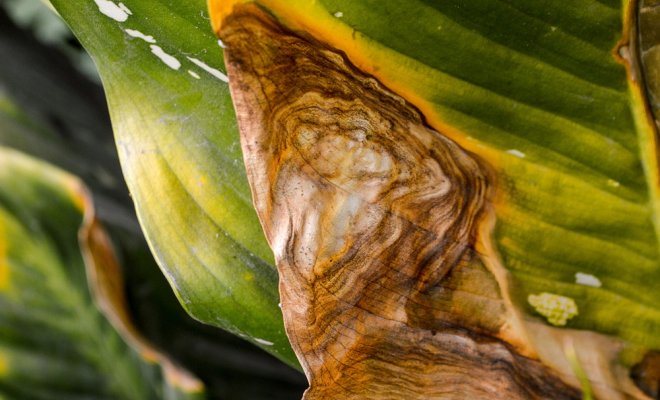

Other growing problems
Why is Dieffenbachia crying? Most often this happens due to high humidity in the room or due to too frequent watering. In addition, drops can be observed at the edges of the dieffenbachia leaves before the rain. If droplets appear only occasionally, then this is normal. But if the drops are constantly on the plant and flow down to the ground, then you need to urgently reduce the watering of the bush. It is advisable to stop watering the soil altogether until it dries out to a depth of about 3 centimeters. So that there are no drops around the edges, a drainage layer must be laid on the bottom of the pot and several holes must be made in the pot to drain excess water into the pan. It must be remembered that in the autumn-winter period it is necessary to significantly reduce watering, then dieffenbachia will not have drops at the edges.
[collapse]
Optimal conditions for the development of dieffenbachia at home
Dieffenbachia, although it is a favorite resident of the windowsills of many houses and offices, still requires a lot of care. Dieffenbachia is very moody, therefore, those who grow it often face various difficulties. It is necessary to choose a place for a pot with an indoor flower based on the color of the leaves. If they are monochromatic, then the plant should be placed in the back of the room, away from light. Dieffenbachia tolerates shade well... But in this case, she will need additional lighting, especially in winter. In any case, it is necessary to avoid windows on the south side, since the plant may die from direct sunlight.
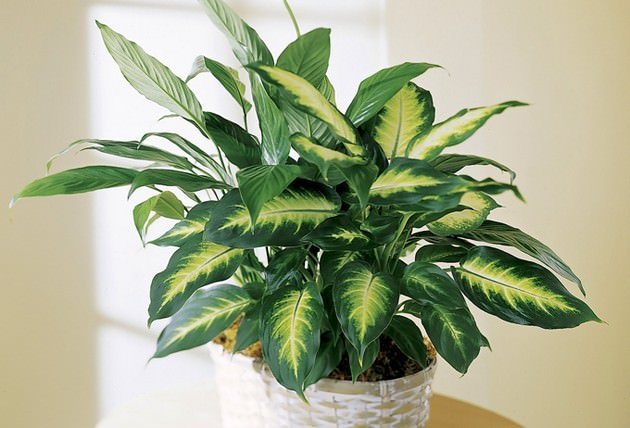

The correct development of the tree also depends on the temperature. So for the warm season, the permissible rate in the room should be + 21 + 25. In winter and autumn, the air temperature should be from +15 to +20.In places where the flower pot is located, there should be no drafts, wind and sudden changes in temperature. For watering dieffenbachia, you need to use pre-prepared water, which was infused for at least a day. In the cold season, you need to water the soil after its top layer has dried out a little. In summer and spring, watering should be regular and abundant. Drying of the soil is not allowed.
Dieffenbachia responds very well to water treatments, for this you need to periodically spray it from a spray bottle. This should be done so that excess moisture does not get on the soil, it can be covered with polyethylene. If the plant is already large, the leaves can be wiped with a damp cloth. For the proper development of dieffenbachia, feeding is necessary. To do this, you need to select fertilizers that do not contain lime. The procedure is carried out on average three times a month.
How does the choice of lighting affect dieffenbachia?
Dieffenbachia is very dependent on the quality of lighting, so this is the first thing to look for in case of leaf problems. If Dieffenbachia does not receive enough light, then its leaves turn yellow. This can happen if the plant stands in the back of the room, where the light simply does not reach it.
Also, for residents of the lower floors, the windows can be shaded by trees or face the north side. If this is the case, then it is worth thinking about moving the dieffenbachia: either put it closer to the window, if possible, or move it to another room where the lighting is better.
Important! There is another important point when choosing lighting. Since Dieffenbachia is a fairly large plant, it is most often located on the floor, in which case the plant receives side light from the windows.
In this case, the top begins to reach for the light, and the plant can lean towards the light source. To avoid this, it is necessary from time to time to turn the plant towards the light with the less illuminated side, so it will develop more evenly and will have a more accurate appearance.
Tightness
In very small pots, the plant becomes so crowded that it can no longer fully develop. At the same time, its growth slows down, it does not give new shoots, its leaves begin to turn yellow, starting from the bottom. Regular transplanting into new soil helps to preserve the decorative appearance of Dieffenbachia.
The plant has a fairly strong root system, which grows rapidly in the first years of life. Therefore, young plants need to be transplanted annually into new soil and a larger pot. With regular transplanting, the flower retains most of its leaves, losing only the lowest. If you skip the transplant, then this will immediately affect the appearance of the young plant, the leaves of which will begin to turn yellow and die off.
Priming
When the soil is swamped, the leaves of the entire culture begin to turn yellow. To restore the life of the plant, it is necessary to transplant it into new soil and process the roots. How to do it:
- Prepare new soil for decorative deciduous crops.
- Move the crop without damaging the roots.
- Carefully remove places of decay. Cut off areas must be treated with crushed charcoal or activated carbon.
- Choose a pot that matches the size of the root system. After processing the roots, their number can be significantly reduced. You should not transplant the culture into an old pot. In a large container, the roots will start to rot after watering, so it's best to pick up a small pot.
After replanting the bush, you must follow the watering rules.
The reason for the yellowing of the leaves can be a lack of water. In this case, the yellowness is insignificant, but the leaves themselves become dry. To restore the life of the bush, the plant should be properly watered. With the systematic drying out of the soil, the bush will die.
Pest infestation
When a spider mite is affected, yellow spots first appear on the leaves of the plant, which then capture the entire leaf plate.
This pest is easy to spot on the underside of the leaves, which may be completely covered in fine cobwebs. Usually, treatment with special chemicals allows you to quickly destroy the pest.
Already yellowed plates are not restored... Over time, they dry out and fall off. But the elimination of errors in the care of the plant will lead to the regrowth of young healthy greenery.
Shrub varieties will become lush and green in color. Old tall plants that have lost their leaves are best updated by cutting and rooting the tops. After that, new plants need to create optimal conditions for growth and development.
Why do the tips of the leaves dry in Dieffenbachia
When growing Dieffenbachia, growers often face drying out of the tips of the leaves of their plants. Often they cannot eliminate this problem, since it is very difficult to establish what exactly causes the leaves of the plant to dry out.
Dieffenbachia is a rather capricious indoor species that can react in this way to almost any unfavorable factor.
Most often, the tips dry out when:
- Low air humidity;
- Overfeeding the plant with fertilizers.
Insufficient air humidity can even lead to complete drying of the leaf blades of the plant.
But the tips can dry out when this factor is combined with high ambient temperatures.
Most often this happens in the summer, when heat suddenly sets in when the humidity is acceptable for the plant. To prevent the leaves from drying out, the humidity must be increased even more. It is necessary to create a corner of the tropical climate for Dieffenbachia, and this is not easy in a city apartment.
Sometimes the leaves of the plant begin to dry at the edges due to the abundant feeding. To prevent the leaf blades from turning yellow and then falling off, it is necessary to stop feeding for 1 month, and then start feeding with caution. And to restore the beauty of the plant, you can cut off the dry parts of the leaves with scissors.
Did you like the article? Share it with your friends on social networks:
My dieffenbachia leaves turn yellow and the tips dry, I just don't understand what to do with it. I'll try everything that is written in the article.
My has become long, there are no leaves, thanks, I will save.
Let's summarize
So, in conclusion, I would like to say that in most cases, dieffenbachia leaves turn yellow with improper care. Therefore, we remind you that you need to put the flower in a well-lit place, but protected from sunlight and drafts. Dieffenbachia needs to be watered abundantly, but excessively. That is, the soil in the pot should be slightly damp all the time. In addition, you should spray the air around the flower or place a wide container of water near it.
Well, if the leaves on your Dieffenbachia turn yellow naturally, then just remove them in time. And let this variegated tropical wonder, like a palm tree, decorate your home and stay healthy. Good luck!
Low air humidity
With insufficient watering and low humidity, dieffenbachia leaves begin to turn yellow from below. First, the tips turn yellow, then the entire leaf blade. Such plates dry out and fall off over time. This is often accompanied by a loss of color and lightening of the upper leaves.
Often, in a city apartment, it is difficult to create the necessary air humidity for dieffenbachia... In summer, the room is quite hot and dry, in winter, during the heating season, the air is greatly dried by heating batteries. Therefore, for many inexperienced growers, dieffenbachia is a long, bare trunk with several leaves at the top.
For a plant to retain its beauty, regular watering and spraying is not enough. It is useful to place it in a pallet with a damp substrate: expanded clay, sand or moss.The substrate will humidify the air near the plant, as well as help preserve its green mass.
Diseases and pests
Dieffenbachia is often affected by various diseases. Among fungal diseases, the following are more common on this culture:
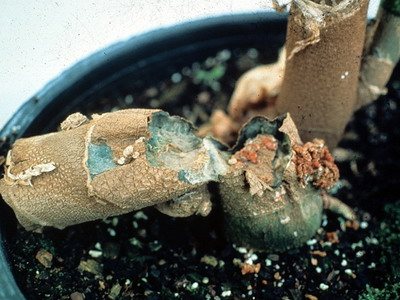

- Anthractosis. The foliage is covered with small orange-yellow spots, which gradually grow and lead to drying and leaf fall. The disease appears if the room is too dry and hot. Spraying with fungicidal preparations will help.
- Spotting. The spots appear starting from the lowest leaves. Spread throughout the crown. The leaf gradually dries up, then dies. All affected leaves are torn off so that the disease does not spread to the rest.
- Fusarium. Dark yellow spots appear on the foliage, then the flower withers and dies. May appear as a result of lack of nutrition and dry soil in the pot. It is necessary to completely replace the substrate, rinse the roots well and treat with special preparations.
- Root rot. It develops due to excessive watering. Fungal colonies first infect the root system, then the entire bush dies. The plant is removed from the planting container, the soil is shaken off and the affected areas of the root system are removed. Then they are planted in a fresh substrate.
- Bacteriosis It appears as clear watery spots along the edges of the leaf plates. For treatment, drugs with a high copper content are used.

